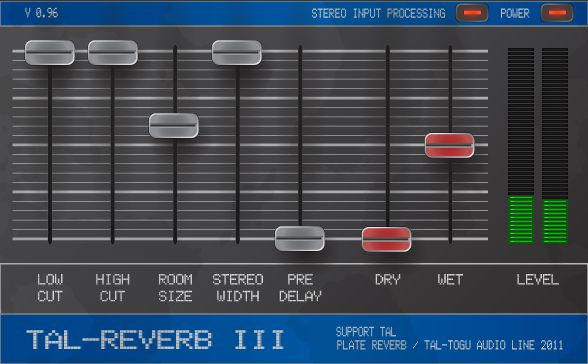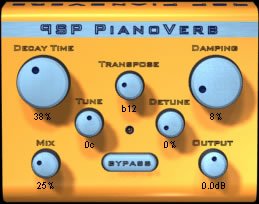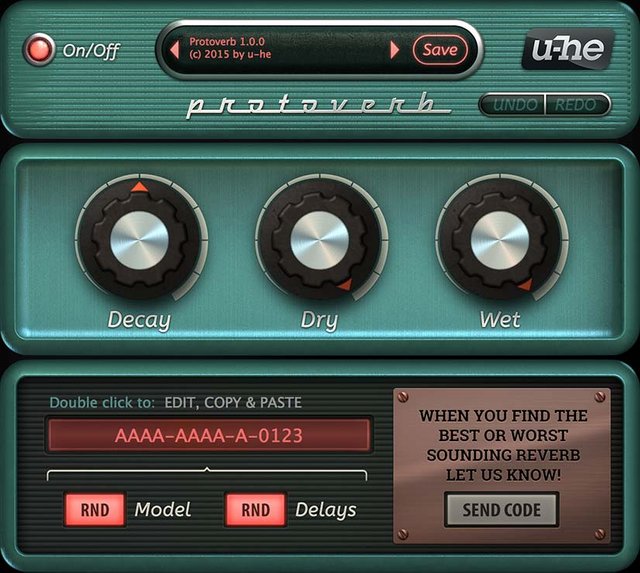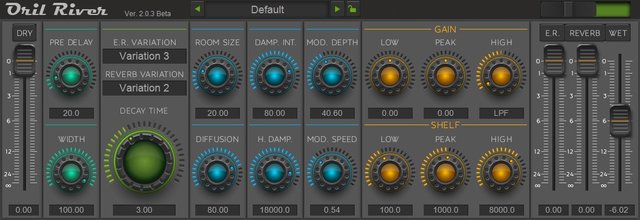- Looking for a killer free reverb VST but overwhelmed with the number of options?
- In this reverb VST shootout, we put 6 of the most popular KVR reverbs head-to-head
- We include audio samples of each to help you save time.
Freeware is always a very exciting prospect for us music-makers, because nobody likes to waste money when there’s a perfectly capable free alternative.
However, many times, you get what you pay for, and freebies don’t quite cut it, so we’ve decided to check out some of the most popular free reverb plug-ins to find out if they're worth your time.
TESTING OUT THE 6 BEST FREE REVERB PLUGINS (HOW WE DID IT)
To test the different reverbs objectively, I needed them to be acting in the same roles, so I created two different scenarios to see how they all fared in these two situations.
The first scenario is a simple test of the reverb's capabilities on vocals. Each reverb has been dialed in with pretty aggressive settings to showcase the long-tail of the reverbs:
- A medium-long decay of around 7 seconds
- Wetness set to 50%.
- All other parameters are left on the plugin's factory defaults.
In both scenarios, there is minimal post-processing on the groups to which the reverbs are feeding, intended to fit the feel of a more finished production in each style.
#1. TAL Reverb III Review

The first of our freeware reverbs comes from Togu Audio Line, TAL, as the follow-up to their previous free reverb, TAL Reverb II. While the GUI isn't going to be winning any design awards, I have a few comments on the reverb itself.
More importantly, the fader labeling is a little confusing. When I see “Low Cut” or “High Cut,” I expect an equalization curve that filters all frequencies above or below a specified frequency, and when I see a fader named as such, I expect that it raises or lowers the frequency of its respective filter. This is not the case in TAL Reverb III.
Instead, there are two bands, a low band and a high band, with a hard-coded crossover frequency. “Low Cut” and “High Cut” adjust the volume of these bands relative to one another. Of course, once that is understood, it’s not difficult to use, but the labeling of the controls could've been a little less misleading.
Moving on to flexibility, it doesn’t have much. As previously stated, the crossover frequency of the two bands cannot be adjusted, the built-in equalization is rudimentary, and there are a total of 9 parameters that can be adjusted, with the inclusion of Dry, Wet, and On/ Off. Simple plugins can be very useful, but this limits customizability. So if you don’t like the way that TAL Reverb III sounds when you load it up, there’s not a lot you can do to fix it.
So, how does it sound? Very noisy. You have the ability to adjust a couple of time-based characteristics, and even stereo width, but the timbral quality is pretty much set. If it’s what you’re looking for, perfect.
It’s a super simple, no-frills plate reverb that adds a noise-like tail to most any source signal. I can see why this one is so popular -- it's definitely useful if you're after a reverb that cuts through the mix.
Download the Tal Reverb III here (opens in new tab)
#2. PSP Pianoverb Review

PSPaudioware has created a very interesting plugin in Pianoverb. As stated on their website, “PSP PianoVerb reproduces [a] special kind of reverberation originally provided by piano strings. It generates reverberation using twelve string operators with adjustable damping and decay time. Each of them is tuned to a particular note starting from A (55Hz) to a G# (103.8Hz). The PSP PianoVerb string system can be transposed in the range of +-24 semitones, tuned within a range of +-100 cents and be detuned as well. Transposing to lower octaves produces a bigger and less resonant sound similar to traditional reverbs, while in turn transposing to higher octaves produces a very bright harp-like effect.” Obviously, it’s a very non-standard reverb, which makes it less useful in broader applications, but it’s very unique, which earns it some merit.
The GUI is small, but straightforward and effective, which makes it easy to get the desired results quickly. Because of its unusual programming, the parameters list is a little unusual as well, consisting of mainstays of the average reverb, such as “Decay Time,” “Damping,” and “Mix,” but with the addition of “Transpose,” “Tune,” and “Detune,” all used to change the pitches of the piano resonances in various ways.
Regarding its sound, it suffices to say that it’s appropriately named. Pianoverb sounds like the sustain of a piano coming out of the sound source to which it’s applied. This is particularly interesting on an atonal sound, such as the snare in the second experiment, which produces the tail of a dissonant note cluster ringing out into the open space between the kicks.
This is a plugin I really like, and intend to use more in the future. I would call this more of a creative effect than a traditional reverb, but however you look at it, it’s a fun plugin that has a place in the arsenal of any experimenter.
Download the PSP Pianoverb here (opens in new tab).
#3. u-he Protoverb Review

Protoverb is not freeware, not according to u-he, anyway. They call it “researchware,” and that’s a more apt description, I think. Protoverb was designed to help u-he determine the best design for reverb algorithms, by hiding almost all of the expected parameters behind unreadable text blocks.
Available to the user are controls for adjusting the decay of the reverb, the volume of the dry signal, and the volume of the wet signal. Additionally, there are two randomization controls: one for the delays, and another for the reverb model. These generate random text blocks that the plugin uses to determine the characteristics of the reverb, and can be copied and pasted to revive a previously used preset in a new instance of the plugin.
Virtually screwed into the front of the interface is a copper plate with an inscription that reads “WHEN YOU FIND THE BEST OR WORST SOUNDING REVERB LET US KNOW!” along with a “SEND CODE” button. Essentially, this allows u-he to collect information from its user base about what sounds good and what doesn’t, without any of the preconceptions that come along with knowing what your settings are.
It’s a decent sounding plugin, with a wide variety of sounds, but given that there’s little control over them, it can take a bit to find a sound that you like. Since you can type in your own text for the reverb to base its sound off of, theoretically, you could eventually work out how each parameter is being changed by what assortment of characters and be able to use it competently.
This is a wonderful plugin for a few situations. If you don’t know quite what you’re looking for from your reverb, load this up and get to button pushing. If you’re bored with your other reverb plugins and want a reprieve that takes away your tired, old workflow, Protoverb is the one for you. If you’re really, really passionate about u-he’s reverb research, there’s nothing better.
Download the u-he Protoverb here (opens in new tab).
#4. Voxengo OldSkoolVerb Review

Voxengo’s offering, entitled OldSkoolVerb, is one of the more option-dense plugins on the list, with parameters for pre-delay, space, time, width, damping, dry/wet, and an in-built EQ module. This customizability certainly makes it more versatile than each of our previous contenders, and better suited to consistent use by the cost-effective producer.
Where there is damping both high and low, the crossover frequency is fixed, as are the frequencies of each of the three EQ bands. This is not inherently bad, and there is certainly a potential detriment to being overloaded with options, but this is far from running that risk.
Voxengo has provided enough options here to be useful, and perhaps even quite powerful, but OldSkoolVerb is still on the simpler side.
It’s not a Swiss Army knife, but it’s more than just a folding blade. I would consider it to be an excellent balance for novice producers to get the hang of the concepts involved in reverb application, or for an experienced producer who is well aware of what they can and can’t get out of this plugin.
Moving on to the pragmatic side of its usage, the interface for OldSkoolVerb is no frills, but not unattractive either, and neatly organized for efficient use. This makes it very simple to start playing with it and have instantly gratifying results. In my testing, I found it easy to get a pleasing sound, though it lacks an element of realism. It doesn’t sound bad, or phony, just not particularly organic, as can be found in some higher-end reverb plugins.
A fun, if frivolous, feature of Voxengo’s freebie is a settings menu with a UI color setting. If the standard grey appears uninviting and sterile, switch it to a warmer hue, like a beige, or try out red for a boisterous pop of color. While little details of this nature are completely unnecessary, they certainly augment the user experience, and there is value in that.
Download the Voxengo Oldskoolverb here (opens in new tab).
#5. Denis Tihanov OrilRiver Review

OrilRiver is a further step forward in complexity, sporting a three-band EQ complete with frequency adjustment, faders for early reflections vs late, modulation, diffusion, and multiple reverb models.
I would also say that it makes progress on the frontier of attractiveness, with a higher resolution, larger knobs, realistic shading, and lifelike texturing, all contributing to a feeling of superior quality and attention to detail.
An important point to note: I am using macOS 10.12.6 to test OrilRiver v2.0.3 Beta with Logic Pro X. Logic scanned this plugin and did not authorize it, requiring me to manually choose to use it. Obviously, this is not preferred, though I have suffered no ill effects from its use yet. This is just something to consider, as willfully opening a crash risk in your DAW is not recommended.
Starting from the left of the interface and working our way to the right, we have the ability first to decide how much dry signal we want to incorporate into our reverb, followed by our pre-delay and stereo width, which I believe to be in milliseconds and percentage respectively, though units are not labeled.
Following are controls for various models of early and late reflections, and an extra-large knob that affects the decay time. Room size and diffusion are next, and then damping. The two knobs that affect damping are labeled “DAMP. INT.” and “H. DAMP.” Though the labeling is a bit unclear, “DAMP. INT.” seems to be the amount of damping, and “H. DAMP.” is the frequency above which damping takes place.
Next is modulation depth and speed, and then the EQ module, complete with three bands that all have independent frequency and gain controls. Lastly, the faders to blend in early vs late reflections, and the fader for the wet signal.
Interface-wise, the decision to separate the faders for the dry and wet signals is a bit strange. In addition, nitpicky though it may be, some of the labelings are unclear at best, and confusing at worst, which could present a challenge for those unfamiliar with the industry standard terms and common tendencies of reverb software.
Overall, it’s a pretty decent plugin, though I wouldn’t be willing to use it consistently without getting the go-ahead from my DAW first.
Download the Denis Tihanov Orilriver here (opens in new tab).
#6. Smartelectronix Ambience Review

Closing out our list is Smartelectronix Ambience, which is the most customizable free reverb vst of the six. All the work on this plugin clearly went into the algorithmic design, seeing as the interface displayed in Logic is identical to those presented by Apple’s most basic Audio Units that come packaged with every Apple computer.
Separated into six sections, Ambience is pretty simple to use, but can create a variety of reverb sounds, everything from an 80s style gated reverb to a long hall or a short tail.
Ambience has the potential to be overwhelming for a beginner, but if you know what you’re looking at, it’s really pretty simple. Gating is done by three sliders, representing attack, release, and gating amount. Decay time and diffusion make up the next section.
The shape section allows configuration of room size, quality vs CPU usage, stereo width, pre-delay, and even selection of a seed for the pseudo-randomness of reflections. Damping takes place in two bands at frequencies of the user’s choosing, and a basic two-band EQ follows.
Lastly, there are two simple sliders for the ratio of dry signal to wet round out the plugin.
All in all, it’s simple, configurable, and effective, making it one of the best free reverb plugins on this list.
Download the Smartelectronix Ambience here (opens in new tab).
FINAL THOUGHTS
Ambience is probably the most versatile out of all of them, but personally, my top pick goes to Pianoverb.
I’ve got to give Pianoverb the win because it does something truly unique, and that’s just really hard to find, even amidst the abundance of plugins in circulation today.
Ambience, OrilRiver, and OldSkoolVerb all sound a little different and have their quirks. But at the end of the day, they’re all competing for the home run, while Pianoverb is sitting down in the outfield eating grass. It’s not the best reverb plugin in the world; and it’s definitely not the most useful or widely applicable; but for a free reverb plugin it outshines the competition.
Following Pianoverb, my ranking is as follows:
- Ambience
- OldSkoolVerb
- Protoverb
- OrilRiver
- TAL Reverb III
We'd love to know what your favorite free reverb plugin is out of this bunch. Or if we've missed an important one that isn't on here -- let us know!

Congratulations @producerhive! You received a personal award!
You can view your badges on your Steem Board and compare to others on the Steem Ranking
Do not miss the last post from @steemitboard:
Vote for @Steemitboard as a witness to get one more award and increased upvotes!
Downvoting a post can decrease pending rewards and make it less visible. Common reasons:
Submit